Published on May 12, 2013
It was clear day, VFR and with smooth seas when LTJG Robert “Rocket” Rabuse and his B/N, ENS Al Hux, USN, circled the USS Lexington for a landing. At the time, the ship and squadron, VA-42 “The Green Pawns”, were doing carrier qualifications and both of the flight crew members were new to their A-6E Intruder. With the extensive training the two men had, they were eminently prepared for the “trap”, US Navy parlance for an aircraft carrier landing. Such carrier qualifications were a routine, if dangerous part of the training required for Naval pilots. Today’s flight, however, wouldn’t end well — despite nearly everything being done correctly. Luckily, nobody would die, though the plane would go down in Naval history as “the one that flew away.”
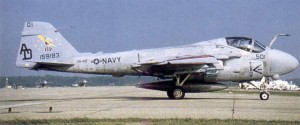
The Events of May 12, 1987
When LTJG R. Rabuse and ENS A. Hux made the final turn and called the ball (a light indicator on the ship that gives reference to the approach angle), they had no idea that their flight would end up a part of Naval history. It was May 12, 1987 — today in aviation history — and the men were confident if a bit nervous of their qualifications, as was typical for young pilots joining the fleet.
Their final landing checks were complete and all that remained was to fly it down to the deck and make a landing. It was a reasonably good approach and the plane stayed roughly on center as the pilot flew down toward the deck, generally on glide path. In the final seconds, LTJG Rabuse over corrected and pulled off too much power, causing the plane to begin to settle, perhaps 5 or 10 feet below the glide path. Such mistakes, however, were normal in both carrier qualifications and in regular fleet work as pilots adjusted and flew the planes onto the deck.
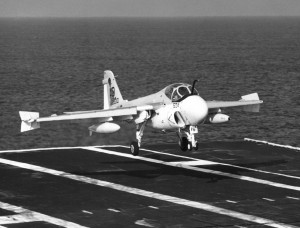
The Terminal Phase
Over the radio, the Landing Signals Officer (LSO) handled the under power situation as a routine matter. He’d seen it all before a hundred times. As the A-6E mushed a bit below the glide path on short final, he issued a routine correction call — “More power.” LTJG Rabuse applied a gentle nudge of the throttle and the A-6E Intruder came up onto glide path, even going a few feet high before if touched down.
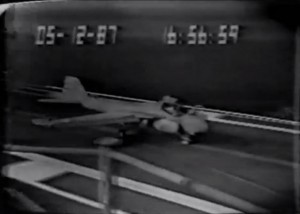
On hitting the deck, the LTJG Rabuse applied full power (MRT), a normal precaution in the event that the plane had missed all the “wires” (arrestor cables), thus allowing them to simply take back off and try again. They “caught a 4 wire”, i.e., the fourth cable on the deck. As the cable spooled out, slowing the jet, nobody suspected that in less than two seconds, the two men would be swimming.
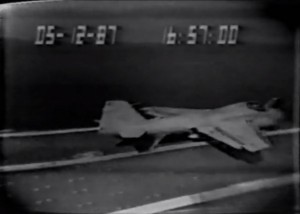
It all happened very quickly. The tail hook broke. In more technical terms, the Navy calls it a “hook point departure”. The end of the tail hook, sometimes called the “stinger”, snapped off. Sometimes when that happened, a plane that hadn’t yet slowed enough could just lift back off and, without a tail hook, take a course for NAS Pensacola for a normal landing on land. This time, however, the aircraft had already slowed considerably. It was well below flying speed.
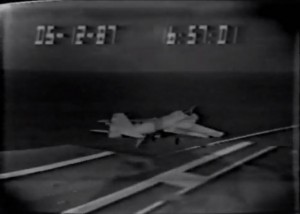
With full power on, the two men found that they were now accelerating as the plane headed off the angled deck of the USS Lexington. Even though the P-8 engines spooled up quickly, there wasn’t really enough deck for them to properly fly it off. Instead, the instant they went off the end of the deck, the plane settled downward toward the water.
The LSO’s voice was screaming over the radio — “Power! Power! Power!” — but they’d already done that. As the plane disappeared below the line of the deck, falling out the LSO’s sight, it was clear that the two men were destined for the bottom of the Gulf of Mexico.
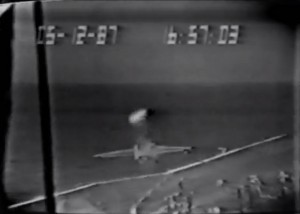
“Eject! Eject! Eject!” came the call.
Out and Up
When the command comes over the radio to eject, you don’t question it. Your knowledge in the cockpit isn’t complete — maybe there is a fire you don’t know about, or a piece of the plane maybe fell off or maybe there’s something else terribly wrong. You can’t tell and in the one or two seconds that separate you from life and death, there isn’t a lot of time to ask questions. Training takes over and you pull your legs in, grab the handles and pull. Ejecting is dangerous, but it is better than dying in a stricken airplane when it crashes.
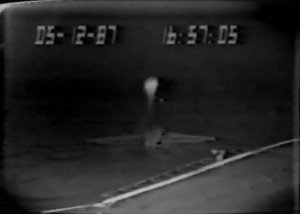
ENS A. Hux was the first out. He pulled the handles and was gone. Within a second and a half, “Rocket” Rabuse pulled and was out as well. Both men’s seats separated correctly and their parachutes opened. Seconds later, after less than a full swing in the ‘chute before hitting the water, they were both swimming off the port bow of the USS Lexington. At that point, flight training lessons were not longer of much use. A different regime of training takes over — memories of the dunk tank, of flipping inverted into the water pool at Pensacola, and of lectures of water survival are suddenly all that count. Free yourself from the ‘chute’, check/inflate your life vest, situate yourself, check for injuries, find any others….
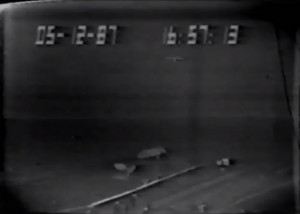
Pilotless, the A-6E Intruder, however, had no intention of landing. Suddenly freed of more than 800 pounds of equipment and perhaps another 400 or 500 pounds of combined pilots and uniform equipment, the aircraft’s center of gravity (CG) was shifted aft. With its suddenly lighter weight, the plane’s stall speed was also instantly lowered. What before had been a certain crash, now turned into a steady and increasingly steepening climb out. Unmanned, the Intruder dangerously soared up and away from the deck.
On its own and pilotless, the plane flew itself back into the sky.
The End of the Intruder
As the Air Boss, LSO and others watched, the Intruder soared up, curving skyward into the clear air off the port bow. For all intents and purposes, it looked like the USAF’s famed “Cornfield Bomber” of about three decades earlier, except for one thing, this plane wasn’t going very far.
As it climbed, its angle steepening from the aft CG, it soon ended up in a stall. The plane then fell off its near vertical ascent and plunged downward. Frighteningly, the USS Lexington was sailing straight toward the point where the descending plane would hit. With a ship of that size, changing course was not really possible. As everyone watched, the plane hit the water just 300 feet off the bow. Had it fallen off on the other wing or taken a different angle of descent, it would have potentially crashed near vertically into the deck of the ship, doing untold damage. It would have been a modern, unmanned kamikaze weighing 20 tons and loaded with jet fuel.
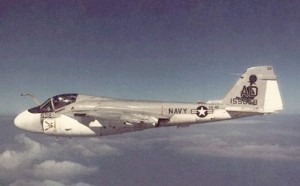
In retrospect, it was a close call. Had the plane struck the Lexington, many men might well have died — but as it was, the plane was just written off, sinking to the bottom of the Gulf.
Shortly afterward, a helicopter standing guard came in and picked up the two men, bringing them back aboard the ship for a much dreaded debriefing.
Watch the Video — CLICK HERE =>
Aftermath
After the fact, hundreds of armchair observers have questioned the flight crew’s decision to eject from what looks like a perfectly flyable plane, at least based on the video. They’re wrong to do so, in fact. The order was clear — whether it was the Air Boss or the LSO who called it out was immaterial and there was no time to ask questions. The words, “Eject! Eject! Eject!” had been called over the radio — in that context, they become an order from a superior officer to follow or face the consequences. In that context, the consequences were quite possibly fatal. Thus, for the two men, it was simply a matter of training and discipline to eject from the airplane.
A later evaluation of the mishap by the US Navy determined that had the flight crew not ejected, the plane would have crashed into the water one or two seconds later anyway. Hitting the water at over 100 knots of speed would have likely been a very bad experience, injuring if not killing the crew outright. Only when relieved of more than 1,200 pounds of weight was the plane again flyable, though even that was a kind of an aerodynamic coincidence that the weight, balance, configuration, trim settings, etc., all added up to a plane that would fly itself.
LTJG Robert Rabuse went on to a full career in the Navy, commanding an S-3 squadron and later becoming an attorney and judge with the rank of a Captain. During his career, he commanded VS-22, and was the CO of NSA Naples Italy.
As for the A-6E Intruder, its loss was just part of the normal training process, factored into the Navy’s plans and budgets as the regular “cost of doing business”. Of course, when viewed from another aspect, millions of dollars of equipment crashed and sank into the water that day.
Was it wasted? In a sense, not really. However, it was a rather expensive training flight.
Bonus Video :: An A-6 Intruder Takes the Barrier
While on deployment, an A-6 Intruder got into trouble with a mechanical problem — at night, in bad weather. Flown by Capt. Rand “Atlas” McNally, USMC, the A-6 Intruder crashed into the barrier successfully “trapping” to make a successful landing — a rather different way to get back on board the USS Ranger. The events came to pass on March 9, 1987. The CAG LSO talking the pilot down, CDR John “Bug” Roach, a legend in the US Navy, demonstrated the extraordinary professionalism that was his trademark. The video is nearly 20 minutes long (though after the 15:00 minute point, it is just static). Notably, it includes the full instructions for the approach, as well as the post-landing shut down and recovery on deck. The plane and pilot came through it fine.
Sadly, “Bug” Roach was killed on October 2, 1991, while on an adversary flight in an A-4E Skyhawk off the coast of San Diego, California. CDR Roach suffered a catastrophic aircraft failure, losing both his engine and suffering from a failure of his ejection seat. During his career, he made more than 1,000 arrested landings during his flight career, which started in 1966. Throughout his time in the Navy, he never had a non-flying tour. He was and will always remain one of the greatest US Navy pilots in history.
As well, on April 5, 1994, LCDR McNally and his B/N, LCDR McMahon, were both killed when their A-6 Intruder suffered a mechanical failure while they were practicing touch and go landings at NAS Alameda. The plane crashed into San Francisco Bay.
From the Archives
The Cornfield Bomber — when an F-106 Delta went into a flat spin, the pilot had to eject. The blast of the ejection, however, broke the spin and the plane, pilotless, flew away and into the distance, quite a bit farther than the Navy’s A-6E Intruder.

The year referenced for the A-6 barricaded landing aboard the Ranger is not correct. I believe it was 1987, as I worked the Crash crew on Ranger from 85-89 and remember the events of that night, but at this point am not positive about the year it occurred.
Mike —
Checking the article, we had the date correct — we had listed 1987 and that was verified from the crash report. Thank you for you attention to detail and, most of all, thank you for your service in the United States Navy.
In your article “BONUS VIDEO :: AN A-6 INTRUDER TAKES THE BARRIER”, the barricade landing of the A-6 that was piloted by Randy ‘Atlas’ McNally happened on March 9, 1987, NOT in 1991, as in your article states.
When it occurred, I was a helicopter pilot in HS-14 on the USS Ranger and more importantly, a friend and college classmate and dorm mate of Randy. Mike Boris was correct. This did NOT happen “during the immediate aftermath of Desert Shield / Desert Storm”, but well before that.
In addition, on 5 April, 1994, LCDR McNally and his B/N, LCDR McMahon were killed when an A-6 he was flying crashed into the San Francisco Bay during routine touch and go landings at Naval Air Station Alameda following a mechanical failure. LCDRs McNally and McMahon were Reservists with VA-304.
Thank you for the correction — this kind of input is always much appreciated as we try to ensure accuracy in all of our articles.
Thank you again!
Thomas.